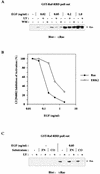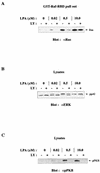Role of phosphoinositide 3-kinase in activation of ras and mitogen-activated protein kinase by epidermal growth factor
- PMID: 10330169
- PMCID: PMC104388
- DOI: 10.1128/MCB.19.6.4279
Role of phosphoinositide 3-kinase in activation of ras and mitogen-activated protein kinase by epidermal growth factor
Abstract
The paradigm for activation of Ras and extracellular signal-regulated kinase (ERK)/mitogen-activated protein (MAP) kinase by extracellular stimuli via tyrosine kinases, Shc, Grb2, and Sos does not encompass an obvious role for phosphoinositide (PI) 3-kinase, and yet inhibitors of this lipid kinase family have been shown to block the ERK/MAP kinase signalling pathway under certain circumstances. Here we show that in COS cells activation of both endogenous ERK2 and Ras by low, but not high, concentrations of epidermal growth factor (EGF) is suppressed by PI 3-kinase inhibitors; since Ras activation is less susceptible than ERK2 activation, PI 3-kinase-sensitive events may occur both upstream of Ras and between Ras and ERK2. However, strong elevation of PI 3-kinase lipid product levels by expression of membrane-targeted p110alpha is by itself never sufficient to activate Ras or ERK2. PI 3-kinase inhibition does not affect EGF-induced receptor autophosphorylation or adapter protein phosphorylation or complex formation. The concentrations of EGF for which PI 3-kinase inhibitors block Ras activation induce formation of Shc-Grb2 complexes but not detectable EGF receptor phosphorylation and do not activate PI 3-kinase. The activation of Ras by low, but mitogenic, concentrations of EGF is therefore dependent on basal, rather than stimulated, PI 3-kinase activity; the inhibitory effects of LY294002 and wortmannin are due to their ability to reduce the activity of PI 3-kinase to below the level in a quiescent cell and reflect a permissive rather than an upstream regulatory role for PI 3-kinase in Ras activation in this system.
Figures







Similar articles
-
Protein kinase B activation and lamellipodium formation are independent phosphoinositide 3-kinase-mediated events differentially regulated by endogenous Ras.Mol Cell Biol. 1998 Apr;18(4):1802-11. doi: 10.1128/MCB.18.4.1802. Mol Cell Biol. 1998. PMID: 9528752 Free PMC article.
-
Phosphatidylinositol 3-kinase is required for integrin-stimulated AKT and Raf-1/mitogen-activated protein kinase pathway activation.Mol Cell Biol. 1997 Aug;17(8):4406-18. doi: 10.1128/MCB.17.8.4406. Mol Cell Biol. 1997. PMID: 9234699 Free PMC article.
-
Activation of the Ras/mitogen-activated protein kinase pathway by kinase-defective epidermal growth factor receptors results in cell survival but not proliferation.Mol Cell Biol. 1998 Dec;18(12):7192-204. doi: 10.1128/MCB.18.12.7192. Mol Cell Biol. 1998. PMID: 9819406 Free PMC article.
-
Regulation of growth factor signaling by FRS2 family docking/scaffold adaptor proteins.Cancer Sci. 2008 Jul;99(7):1319-25. doi: 10.1111/j.1349-7006.2008.00840.x. Epub 2008 Apr 29. Cancer Sci. 2008. PMID: 18452557 Free PMC article. Review.
-
Role of MAP kinase in neurons.Mol Neurobiol. 1998 Feb;16(1):79-95. doi: 10.1007/BF02740604. Mol Neurobiol. 1998. PMID: 9554703 Review.
Cited by
-
The class II phosphoinositide 3-kinase C2beta is not essential for epidermal differentiation.Mol Cell Biol. 2005 Dec;25(24):11122-30. doi: 10.1128/MCB.25.24.11122-11130.2005. Mol Cell Biol. 2005. PMID: 16314532 Free PMC article.
-
PKC alpha-dependent regulation of the IGF1 receptor in adult and embryonic rat cardiomyocytes.Mol Cell Biochem. 2005 Jul;275(1-2):15-24. doi: 10.1007/s11010-005-7264-x. Mol Cell Biochem. 2005. PMID: 16342423
-
Human cytomegalovirus up-regulates the phosphatidylinositol 3-kinase (PI3-K) pathway: inhibition of PI3-K activity inhibits viral replication and virus-induced signaling.J Virol. 2001 Jul;75(13):6022-32. doi: 10.1128/JVI.75.13.6022-6032.2001. J Virol. 2001. PMID: 11390604 Free PMC article.
-
Knock in of the AKT1 E17K mutation in human breast epithelial cells does not recapitulate oncogenic PIK3CA mutations.Oncogene. 2010 Apr 22;29(16):2337-45. doi: 10.1038/onc.2009.516. Epub 2010 Jan 25. Oncogene. 2010. PMID: 20101210 Free PMC article.
-
The role of semaphorins and their receptors in gliomas.J Signal Transduct. 2012;2012:902854. doi: 10.1155/2012/902854. Epub 2012 Sep 23. J Signal Transduct. 2012. PMID: 23050142 Free PMC article.
References
-
- Bos J L. Ras-like GTPases. Biochim Biophys Acta. 1997;1333:M19–M31. - PubMed
-
- Bos J L, Franke B, M’Rabet L, Reedquist K, Zwartkruis F. In search of a function for the Ras-like GTPase Rap1. FEBS Lett. 1997;410:59–62. - PubMed
-
- Buday L, Downward J. EGF regulates p21ras through the formation of a complex of receptor, Grb2 adapter protein and Sos nucleotide exchange factor. Cell. 1993;73:611–620. - PubMed
Publication types
MeSH terms
Substances
LinkOut - more resources
Full Text Sources
Other Literature Sources
Molecular Biology Databases
Research Materials
Miscellaneous
